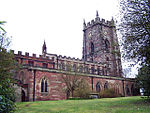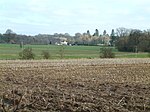Birmingham and Liverpool Junction Canal
Canals in EnglandCanals opened in 1835Geographic coordinate listsHistory of StaffordshireLists of coordinates ... and 3 more
Shropshire Union CanalUse British English from January 2017Works of Thomas Telford

The Birmingham and Liverpool Junction Canal was a canal in England which ran from Nantwich, where it joined the Chester Canal, to Autherley, where it joined the Staffordshire and Worcestershire Canal. Forming part of a major link between Liverpool and the industrial heartlands of the Midlands, the canal was opened in 1835, and merged with the Ellesmere and Chester Canal Company in 1845, which became the Shropshire Union Railways and Canal Company in the following year.
Excerpt from the Wikipedia article Birmingham and Liverpool Junction Canal (License: CC BY-SA 3.0, Authors, Images).Birmingham and Liverpool Junction Canal
Market Drayton Bypass,
Geographical coordinates (GPS) Address Nearby Places Show on map
Geographical coordinates (GPS)
| Latitude | Longitude |
|---|---|
| N 52.9095 ° | E -2.4734 ° |
Address
Market Drayton Bypass
TF9 1HU
England, United Kingdom
Open on Google Maps







